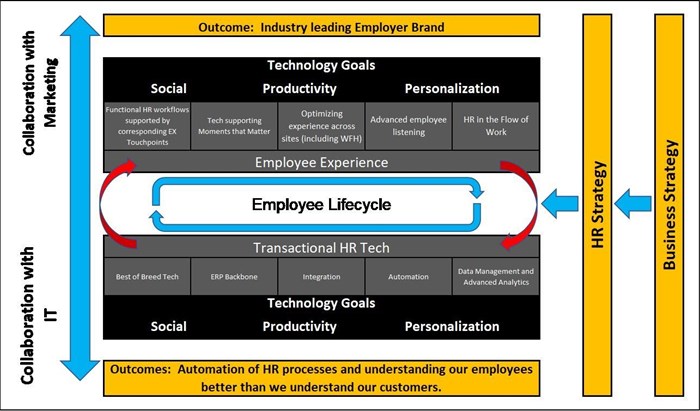
Building the Ultimate HR Tech Stack - part 2
Introduction
The first article in this series discussed how HR tech can help drive the business strategy and that the Ultimate HR Tech Stack is comprised of two groups of tech working as one ecosystem. In this article, we will focus on the first group of tech – the ‘transactional HR’ tech group.
Achieving different outcomes through separate focus areas
While both groups of tech have a lot in common, they are different in what they focus on and the outcomes achieved through them. Let’s unpack each group separately, starting with the foundation group, the group that must be in place first.
Group 1: Transactional HR Tech
Outcomes
Laying the foundation correctly via transactional HR tech leads to two very important outcomes. The first, and traditionally the most important, is the automation of HR processes. By automating HR processes, the organisation increases the efficacy of the HR function and in so doing reduces the costs of executing basic HR processes. The second, and lately vastly more important than automation, is understanding our employees (via advanced People Analytics). HR departments sit on mountains of data. On a case-by-case basis, one can argue that HR has more info on an individual (employee) than the marketing department (customer). Just compare the volume and richness of personal data that HR has about an employee and compare that to the data you have on individual customers. Using this data correctly, HR can understand their employees better than the business understand their customers.
Categories of tech included
The ‘transactional HR’ group of technology includes 7 of the 12 HR tech categories identified by Josh Bersin. These categories are:
- Core HR & payroll,
- Compensation, benefits and reward
- Workforce management
- Talent management
- Talent acquisition
- Performance management
- Learning and development
The 5 focus areas of ‘transactional HR’
The focus areas of each group represent the tactical approach of your HR tech stack. The decisions you take around each focus area and your ability to successfully implement these decisions will ultimately dictate how your HR tech will function.
Under the transactional HR group of tech, there are five elements that you must to focus on:
- ERP backbone: Every HR tech stack is built around one primary system. ERP systems are designed to be wide and cover as many processes as they can. Naturally, this one system cannot do everything for you, but it can do a lot and can provide the foundation from where you can expand.
- Best of breed tech: The trouble with all ERP systems is that, while they are wide to cover almost every HR process, they do not have the depth in functionality that is often needed for specific HR functions. Software that focuses exclusively on a specific process (eg. recruitment) often offers much deeper functionality (eg. applicant tracking systems). The task here is to identify where the ERP is sufficient and where this needs to be complemented by more specialised technology.
- Integration: Every mature HR tech stack will comprise of multiple systems and tools. To enable smart automation and analytics, these systems and tools need to ‘talk’ to each other. There are several different integration strategies you can follow. Work closely with your CTO on this one.
- Automation: Every system and tool you have will provide ‘internal automation’, referring to automation within the system/tool. However, many HR processes and procedures require the use of more than one tool, and therefore inter-system automation must be developed. Luckily, the market offers several process flow tools that allow for process automation that requires various systems and tools to work together.
- Data management and advanced analytics: As mentioned previously, advanced HR analytics (I prefer the term ‘people analytics’), has become a CEO focus point. From day one, the focus on building your HR tech stack must be on building your people analytics capabilities.
Interdepartmental collaboration: HR working with IT
Although collaboration with IT is important from the start, this relationship and collaboration grows stronger as your tech maturity grows. As your transactional HR tech becomes more advanced, the lines between HR and IT almost becomes blurred. In many cases, the IT department employs at least one HR tech specialist, and the HR department employs traditionally IT roles such as business analysts, systems analysts and data analysts.
This article is the second of three in a series around the Ultimate HR Tech Stack. Keep your eyes open for more articles.
About Elmen Lamprecht
Elmen Lamprecht is an executive consultant at 21st CenturyRelated
#BizTrends2025: What’s next for HR and payroll? Top trends to watch in 2025 4 Feb 2025 #BizTrends2025: Future of remuneration - culture, AI, and management shifts 3 Feb 2025 AI in remuneration and payroll - don't fall for FOMO 29 Jan 2025 #BizTrends2025: AI-assisted HR - fast-forward to business value 16 Jan 2025 #BizTrends2025: Salary trends shaping the remuneration revolution 13 Jan 2025 Planning on global expansion? Do not rely on plug-and-play payroll and HR 9 Dec 2024 What 2025 has in store for remuneration packages... 6 Nov 2024 5 steps to successfully adopting new HR technology 30 Jul 2024











